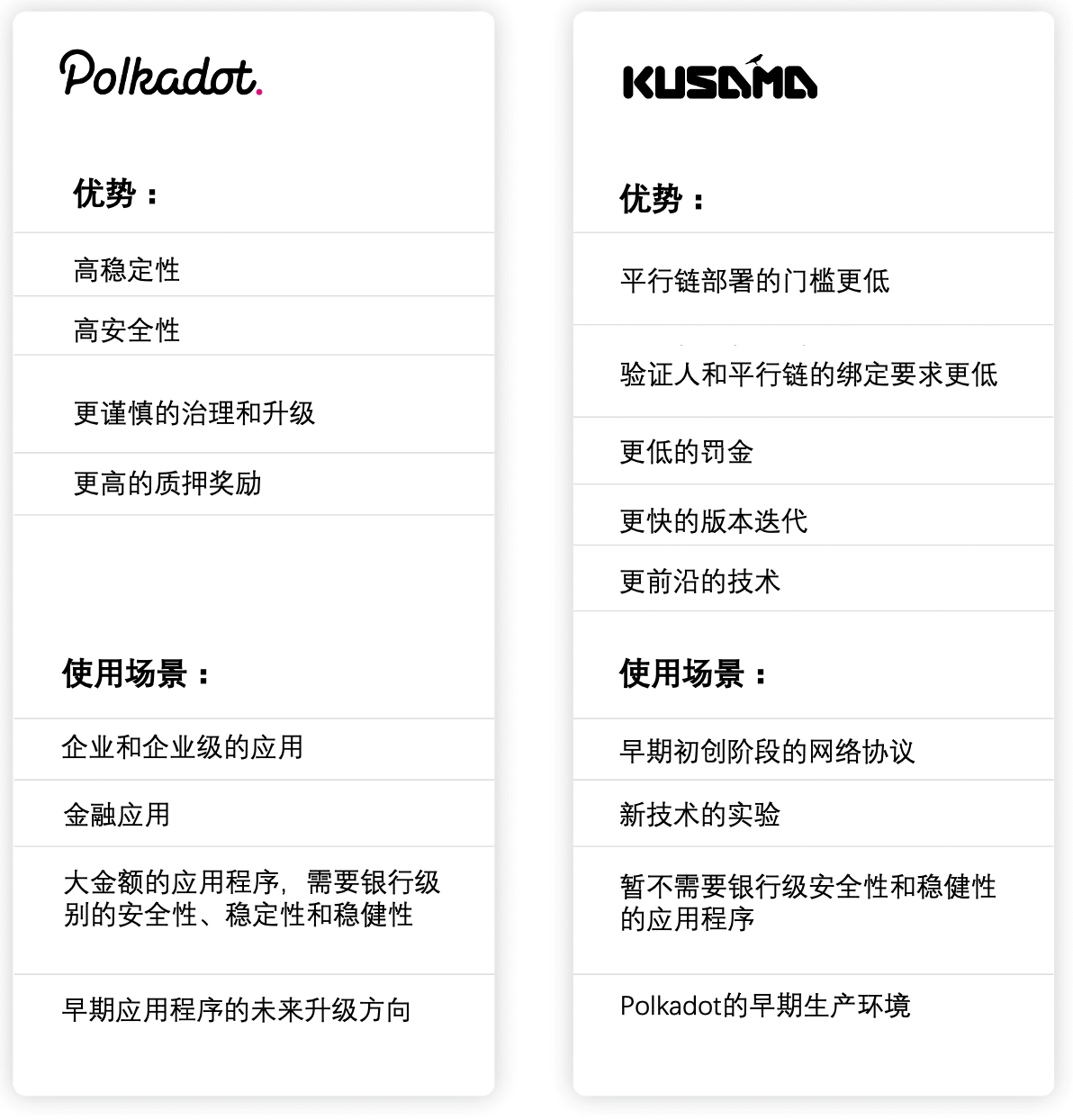
Kusama and Polkadot are two independent and unique blockchain networks. They are built with similar code bases, but Kusama's network governance changes more frequently, and the threshold for building applications on Kusama is also lower. The Kusama network is more wild, and the version changes faster. Polkadot will be a relatively conservative network that pays more attention to stability and reliability. The frequency of Polkadot's governance mechanism will be relatively slower, and the version upgrade mechanism will be more organized. Kusama is a network environment more suitable for experimentation and early deployment. Polkadot is a network that provides an environment for applications that avoid risks and have a higher overall market value.
Since the Polkadot network has been released, many people are asking what is the difference between the Polkadot network and the Kusama network, and how the two networks will develop differently in the future. The following is the difference between the various dimensions we listed, and the difference in application scenarios showing the Kusama network and the Polkadot network: independent of each other, but closely governed and voted by their respective communities.
technology comparison
technology comparison
Because the governance of both networks is decentralized and permissionless. Therefore, the two networks will develop independently, and even merge or fork, led by their respective communities in the future. At the time of writing, we will share with you the similarities and differences between the two current networks.
speed
speed
The first technical difference is that Kusama has modifiable governance parameters designed for faster version iterations, not faster block generation and transaction throughput of the blockchain (the block time and transaction throughput of the two networks speed), but the Kusama network will process governance matters faster, such as having new referendums and enacting approved upgrades. This allows Kusama to adapt to new versions faster than Polkadot and will develop faster.
Why is Kusama faster than network governance in Polkadot? Polkadot itself is extremely cutting-edge technology. Building Polkadot is like exploring uncharted territory: full of unknown dangers, challenges, and detours. With its ability to evolve and adapt quickly, Kusama can move forward like a detective, surveying the terrain ahead and encountering the occasional hazard or stumbling block. With the help of Kusama's scouting efforts, Polkadot can move forward more smoothly and avoid the pitfalls that Kusama experienced.
But the increased speed of Kusama also means that KSM holders will have to stay active and vigilant if they want to keep up with all the proposals, referendums and version upgrades. Kusama is four times faster than Polkadot, with 7 days to vote for referendums and 8 days to implement upgrades after voting. This means that validator versions on Kusama will also be updated more frequently. In contrast, on Polkadot, validators can have up to a month to prepare for version upgrades, so a smoother, longer version is more attractive to validators.
optimization settings
Example
Example
Polkadot will stick to deploying enterprise-grade applications and applications that handle large transactions and require bank-level security and stability. After the release of Polkadot, Kusama will still maintain its current position and become a test platform for more cutting-edge technologies.
Kusama prepares a fully live, fully decentralized, community-controlled blockchain network environment with realistic conditions and incentives, including conditions and economic incentives for real events. The initial usage scenario for Kusama is in a pre-production environment, where a project can be run and maintained as a parachain on both networks at the same time, experimenting and testing new technologies and features on Kusama before deploying them to Polkadot. The team can get a more accurate understanding of specific parachain projects through experiments on the Canary network. Blockchain components or verification nodes can test performance on the Kusama network in the same real environment as Polkadot. After the deployment test in the pre-production environment , the risk of problems later in the project can be reduced. Projects such as Chainlink, Acala, and Moonbeam have mentioned this as one of the main reasons they deployed to the Kusama network.
Another use case for Kusama is to provide a network environment for an early start-up team that is still iterating on its technology and business model. Deploying a parachain in Kusama's low-yield environment will provide developers with greater flexibility while they finalize the platform's design, build a user base, and attract the attention of the community. Next Polkadot will be the upgrade path for those projects that eventually become more mature. Projects that require high throughput but not necessarily bank-like security, such as certain games, social networking, and content distribution applications, are particularly well suited for this use case.
Kusama will prove capable of being a testing ground for the latest technologies such as: governance, incentives, monetary policy and DAOs (Decentralized Autonomous Organizations). Kusama will be more exploratory and adventurous than Polkadot. Participants will conduct some interesting experiments through Kusama governance and the entire community. They can use Kusama treasures as a capital base and try new incentive mechanisms to promote community interest and participation. Kusama has attracted a group of ardent fanatics, some of whom get Kusama tattoos for it.
Upgrades to Polkadot's own runtime will also be deployed to Kusama prior to Polkadot mainnet. In this way, not only can we understand how these new technologies and functions will perform under real-world conditions before introducing them into Polkadot, but project teams that have already deployed to these two networks can gain a more comprehensive understanding of their own project technologies .
 Ultimately, Kusama and Polkadot will continue as two independent networks with their own communities, different frequency of governance changes, and complementary usage scenarios, and maintain a close relationship of mutual support. Many teams may deploy applications to in both networks. In the future, Kusama will connect to Polkadot with a bridge chain for cross-network interoperability. The Web3 Foundation and Parity Technologies will work together on the development of both networks, providing support and guidance to teams within the ecosystem. Kusama will continue to play its original role as a canary network, ensuring the stability and reliability of Polkadot in the future. The direction ahead of Kusama will be up to each user himself.
Ultimately, Kusama and Polkadot will continue as two independent networks with their own communities, different frequency of governance changes, and complementary usage scenarios, and maintain a close relationship of mutual support. Many teams may deploy applications to in both networks. In the future, Kusama will connect to Polkadot with a bridge chain for cross-network interoperability. The Web3 Foundation and Parity Technologies will work together on the development of both networks, providing support and guidance to teams within the ecosystem. Kusama will continue to play its original role as a canary network, ensuring the stability and reliability of Polkadot in the future. The direction ahead of Kusama will be up to each user himself.
Shawn PolkaBase